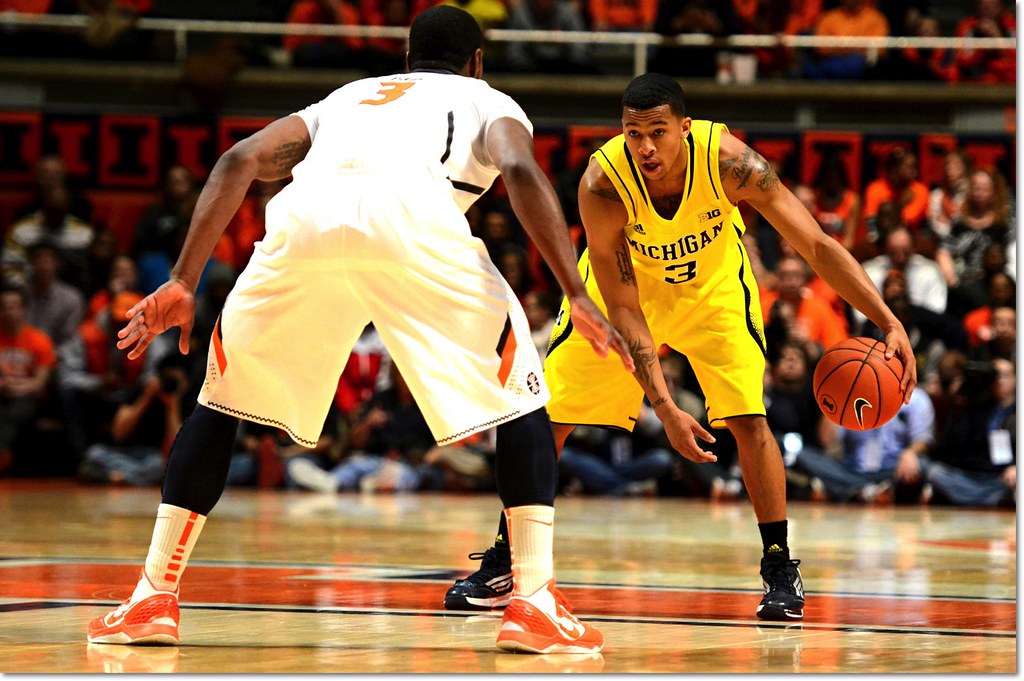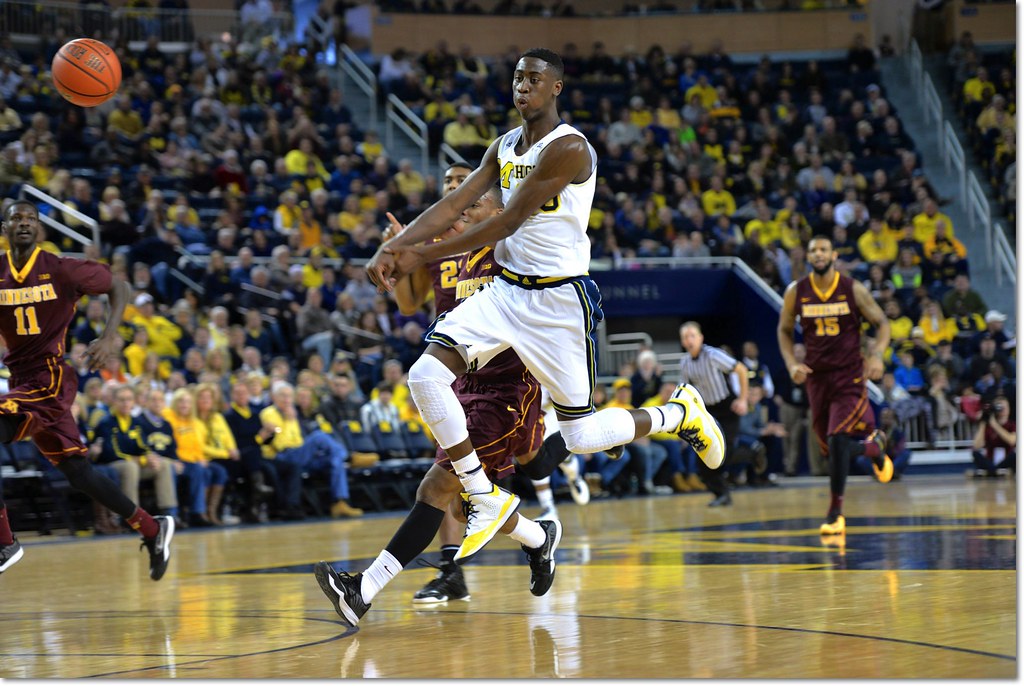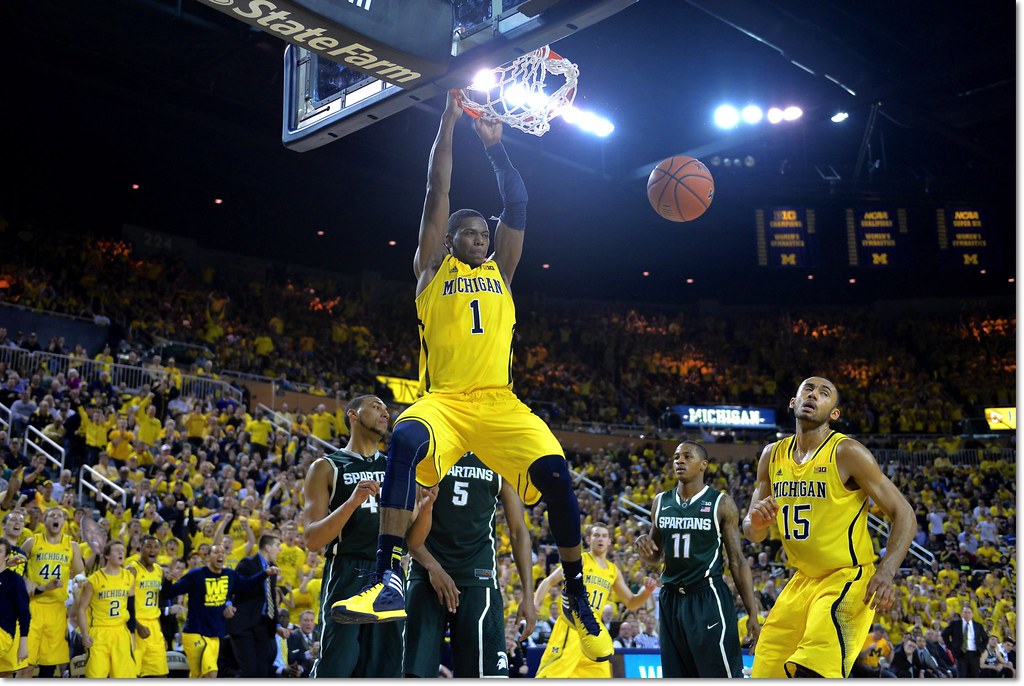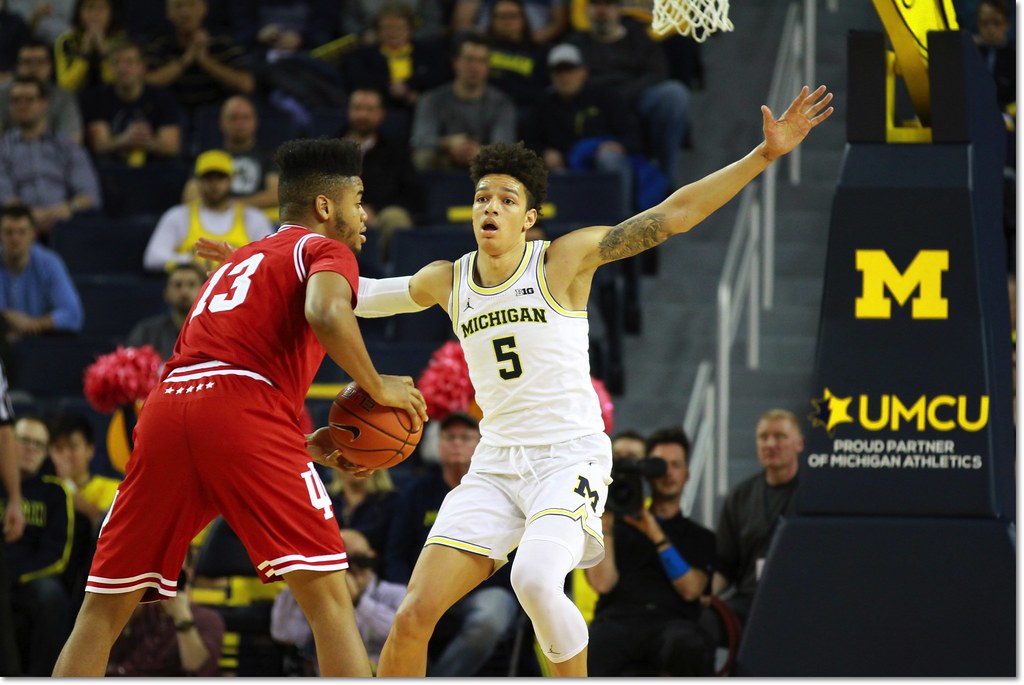The All-Beilein Teams: Small Ball


Pick your poison. [Marc-Gregor Campredon]
Previously: All-Bench, Bench Mob, All-Freshman, All-Senior
John Beilein has spent ten seasons in Ann Arbor. As of the most recent, he's the winningest coach in program history with 215. He snapped Michigan's post-sanction tournament drought in 2009, the first of seven NCAA appearances with the Wolverines, three of which have extended at least into the second weekend.
In recognition of the above, as well as the need for offseason #content, I've put together a series of All-Beilein teams, inspired by this twitter post and the ensuing conversation. My guidelines:
- I'm attempting to put together the best possible lineups, which isn't necessarily the same as picking the best individual players at each spot.
- I'm choosing individual player vintages (i.e. 2013 Trey Burke). A player can only be chosen once for each category, but different player years (i.e. freshman bench gunner 2014 Zak Irvin and well-rounded senior 2017 Zak Irvin) can be eligible for separate categories.
- The same player/year can be chosen for multiple categories—for instance, 2013 Mitch McGary making the All-Bench team doesn't exclude him from making the final All-Beilein team.
Eligibility for certain categories may be slightly fudged because of the limited pool of players.
I'm not putting too many constraints on myself for this exercise since the point is to let our imaginations run wild.
Today's lineup is a fun one. Small ball has taken basketball by storm, and it's a style Beilein teams know quite well. What would the lineup look like if you tried to field a team that could shoot the lights out, switch everything on defense, and provide matchup problems across the board? Here's a squad that would absolutely wreck Purdue.
POINT GUARD: 2012-13 TREY BURKE

Burke vs. Switch. Advantage: Burke. [Bryan Fuller]
Well, yeah, the national player of the year is going to make this team. Burke was a killer off the high screen with his combination of vision, decision-making, passing, finishing, and pull-up shooting. While he didn't have the reputation of a defensive specialist, he graded out well on that end of the floor, and his timely steals would lead to some spectacular transition buckets.
I'd tell you that a team that can space the floor and give Burke room to operate would lead to amazing things, but you already know that, because you also watched the 2013 squad.
[Hit THE JUMP for the rest of the post.]
SHOOTING GUARD: 2016-17 DERRICK WALTON

Walton vs. Switch. Advantage: Walton. [Campredon]
A point guard by trade, Walton spent plenty of time at Michigan playing off the ball, especially early in his career when Nik Stauskas, Caris LeVert, or Spike Albrecht could serve as the primary ballhandler. Walton is an ideal small-ball player. He's excellent running the high screen and even better as a spot-up shooter; among players who used at least 100 spot-up possessions last year, nobody in the country posted a better figure than Walton's 1.50(!!!) points per possession, per Synergy.
As a burlier, stronger guard than Burke, Walton could handle defending bigger two-guards, and his remarkable defensive rebounding would be much-needed in this lineup.
SMALL FORWARD: 2013-14 CARIS LEVERT

LeVert could do it all. [Fuller]
This was a tough choice; it's really, really difficult to leave Nik Stauskas off a perimeter-oriented team. To make a cohesive lineup, however, LeVert is the better option. While he and Stauskas have similar offensive skill-sets, LeVert was the superior passer, rebounder, and defender—and he's no slouch as a scorer, either.
LeVert's length and athleticism would allow him to play in a switch-heavy defensive scheme. Meanwhile, the idea of a Burke-Walton-LeVert backcourt with all at their peaks has me salivating.
POWER FORWARD: 2013-14 GLENN ROBINSON III

Space, cut, obliterate. [Fuller]
When everyone else on the floor has a dangerous outside shot, you can afford to field a player who isn't a deadeye three-point shooter. GRIII was a semi-viable but far-from-ideal 31% from beyond the arc, but everything else about his game lends itself well to this lineup.
An overlooked defender, Robinson used his strength and athleticism to his advantage on that end, even grading out in the 88th percentile as a post defender, per Synergy. We certainly didn't overlook his dunks, which often came off cuts when defenders overplayed Michigan's shooters; in his two seasons at Michigan, Robinson scored 203 points on 139 possessions Synergy filed under cuts for a remarkable 1.46 PPP. While far from a force on the boards, he chipped in more offensive rebounding than your average 6'6" wing, too. Robinson was the ultimate complementary piece in his time at Michigan and he'd fill a similar role here.
CENTER: 2016-17 DJ WILSON

Lanky. [Eric Upchurch]
This was another tough choice, as DeShawn Sims and Moe Wagner work as small-ball centers and Mitch McGary was so good/versatile he could fit almost any lineup. What separated DJ Wilson was three-point shooting and rim protection. Beilein's late-season adjustment to playing Wilson more often as a center helped propel Michigan to the second weekend of the tournament, and much of that had to do with his defense; Wilson could capably switch between guarding wings and bigs and finished the season with more blocks than any Wolverine since Ekpe Udoh.
While rebounding is a concern, the Walton-LeVert-GRIII trio helps out there. On offense, Wilson legitimately stretches the floor (37% 3P), and while he didn't get nearly as many opportunities as Wagner he actually even more effective on a per-possession basis as the roll man off the high screen.
THE CHEMISTRY
Hoo dang, would this team be fun to watch. You could conceivably run a high screen with any combination of players on the floor, including three ballhandlers who are deadly pull-up shooters, and always have a couple dangerous spot-up threats spacing the floor. When that draws in the defense's focus, GRIII destroys Tokyo. While this may not be a great defensive or rebounding team, they'd put up video game numbers on offense to the point I'm not sure any of the other stuff would matter.
HONORABLE MENTIONS: 2010-11 DARIUS MORRIS, 2012-13 TIM HARDAWAY JR., 2013-14 NIK STAUSKAS, 2016-17 ZAK IRVIN, 2008-09 DESHAWN SIMS
Watching Darius Morris run the 1-5 high screen with DeShawn Sims while Hardaway, Stauskas, and Irvin space the floor would be pretty dang fun. This lineup also has solid size for a "small ball" group, with Irvin the only player who's really undersized for his position. Morris may not be an outside shooting threat, but his size and vision would allow him to find shooters from all angles, and everyone else on the floor is a capable spot-up threat—and much more, in the cases of Hardaway and Stauskas.
Some of those photos (esp. the one of LeVert) make me miss The Rock. IIRC, Beilein finally started using a Nike ball as a home court ball in deference to the Nike contract, but he had stuck with The Rock previously because The Rock stuck with him when he was an unknown at Canisius.
I also liked having visiting teams have to get used to a new ball when they played at Crisler.
(It's the little things, sometimes ... .)
How can the "All-small" team not have Zack Novak at the PF/C position?... oh, the emphasis is on "All", not "small".
Even though Caris was here 4 years and Nik only 2, because of injuries, they played almost the same number of minutes. Caris played 2721 to Nik's 2471. That makes statistical comparisons simpler.
Shooting-wise, Nik is the obvious choice with percentages of 0.500/0.441/0.832 to Caris' 0.456/0.401/0.770. But Caris nearly doubled up in the non-scoring stats, 364/275/97/22 for rebs, asts, steals and blocks to Nik's 221/170/42/20.
Interestingly, Nik scored 1060 points to Caris' 1070.
My initial reaction was I'd take Nik over Caris, but after looking at the numbers, I think Caris is the better pick FOR THIS TEAM. Still, that 44% from 3 is hard to pass up.
http://www.sports-reference.com/cbb/players/nik-stauskas-1.html
http://www.sports-reference.com/cbb/players/caris-levert-1.html
just to shoot 3's. Caris is more of an all around player and is a much better athlete. Caris can shoot as well.
Half of Stauskas' numbers was from his freshman year when he was a developing role player. You have to compare Stauskas' peak (sophomore year) with Caris' peak (upperclassmen years when not injured). Stauskas would have a clear offensive edge.
Stauskas was Big 10 POTY and an All-American. Caris is an unfortunate "what-if" story of injuries. Even with Caris' edge as a rebounder and defender, this shouldn't be close in my opinion. Personally, I'd have Stauskas as the 2-guard over Walton and Caris at the 3.
I think I'd put Stuaskas as the SG on this team over Walton, defense would suffer but Nik had the ball handling to do it and has run some PG and SG in the NBA. Levert and Stauskas would also be able to switch more for defensive purposes which could help avoid a situation where a 6'4 SG or PG is just posting up the two smaller guards on a lot of possessions.
but then it wouldn't be the "small ball" lineup anymore. It would just be the lineup.
we don't get see Dj play at M this year..
Good luck kid.
I think I'd take your all honorable mentions team over your starters in a game
2010-11 DARIUS MORRIS, 2012-13 TIM HARDAWAY JR., 2013-14 NIK STAUSKAS, 2016-17 ZAK IRVIN, 2008-09 DESHAWN SIMS
Morris vs Burke: More offense from Burke but Morris crushes him defensively. I'd give Burke the edge but it's not as one-sided as you might think.
Hardaway vs Walton: I think you missed on this one. Timmmay is far more explosive, can finish at the rim and is about the same from beyond the arc. Both good on-ball defenders but Hardaway's additional length gives him the vote for me.
Stauskas vs Levert: No WAY do I take Caris over Nik. Michigan Nik was beyond deedly from deep and not just a shooter so I'm told. Caris more versatle, better rebounder but what I lost in shooting trading Morris for Burke I just made up 10 fold here.
Irvin vs Robinson: Edge to Robinson although both have been known to launch shots which made me go "no,no,no, YES" at times. Irvin too inconsistent (as was Robinson) but GRIII's athleticsm is much better IMO.
Sims vs Walton: I'd take Sims cause I know what I'm going to get every possession of every game everytime. The dude defined the term "lunchpail player" and I need that at the 5. Walton would show flashes but was SO inconsistent you're never quite sure how much performance he's going to give you. He's your Zac Irvin.
Line em up. I'll take the HMs over the first team all day long.
Walton is a guard, so I assume you are talking about Sims over Wilson. I do think Sims was a slightly better player overall, but I like Wilson a tad more in Small Ball. The reasons are because Wilson's shooting and Defensive Flexability are much better then Sims. Sims was not a 3 point threat at all. He had a decent mid range game, but that doesn't stretch the floor near as well as a good 3 point shooter (Which helps open the door for back cuts by Robinson or anyone else). Also on defense there was no way Sims was staying with smaller guards, whereas DJ could. For a true small ball lineup, I think you have to go Wilson.
Wrong name on my part. Thanks for the correction.
than Hardaway. Walton is deadly as a spot up shooter. I believe he shot close to 50% in spot up shooting last season.
Disagree on Nik > Caris. Caris is more of an all around player and can actually play defense. Caris is just as good of a shooter as Nik but can rebound, run PnR(Nik can do it but Caris does more out of it IMO) and pass.
Sims is a bigger bodied player who can step out and shoot 3s. He can bang down low, but Wilson is longer, more athletic and can block shots which is the deciding factor IMO.
That lineup would really struggle in a small ball game I think. With Neither Sims or Morris as outside shooting threats defending the pick and roll would be relatively easy as teams could sag off both players to prevent drives without fear of the pick and pop. You could run it with Stauskas but Sims still doesn't stretch the floor and whoever was guarding Morris would be able to help off because him sitting in the corner really isn't that much of a threat either. That lineup would also struggle defensively, enither hardaway or Stauskas are elite defenders and Morris is long but struggles with small fast guys, an atheltic backcourt would be getting into the lane at will against that team.
I don't blame u,,,,,,,, show me the money. BUT
to quote Dixon Steele (Bogart)
"There's no sacrifice too great for a chance at immortality".......
I'm not sure how you define a center in small ball, but there's no sane lineup that has DJ Wilson ahead of Jordan Morgan.
Small Ball implies a 5-out type offense where you don't really have a true center on the floor, a.k.a the Golden State Warriors when they have the Curry-Green-Thompson-Durant-Iguadola lineup. Jordan Morgan was essentially a true center, good finisher around the rim, good defender and rebounder, but no outside game. DJ Wilson can shoot and take you off the dribble, as well as hit you with a post move if needed. Add his athleticism and he makes a much better small ball center than Morgan.
And his shorter pants - That is very important, pretty sure it is what make him apart of the rest.
Comments